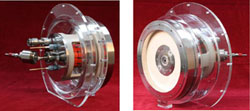Negative ion pulses progress nuclear fusion
The negative hydrogen ion also called the hydride ion is just the usual hydrogen atom with an extra electron added. The addition of this extra electron results in a surplus of negative charge and the creation of the corresponding ion. Negative hydrogen sources driven by radio frequency (RF) are currently extensively used in a number of highly sophisticated physics experiments. Furthermore, next generation accelerators will demand long pulses and high intensities of negative ions. The HP NIS European funded project has successfully undertaken the difficult task of researching these ion sources and producing the required pulses. From an ion source the negative ions are extracted and are then accelerated from a linear accelerator (LINAC) before injection into compression rings. The presence of the element caesium alters the ion extraction properties from the source. In the HP NIS project an uncesiated (no caesium present) RF source was used. The developed innovative experimental design produced record pulse power. The current intensity reached 54 milliamperes. An extraction opening with diameter 6.5 millimetres resulted in current densities as high as 163 milliamperes per centimetre squared. These record high values have never before been achieved by any international experimental group working with uncesiated hydrogen sources. High current and high current densities are not the only requirements from the ion source. The duration of the ion pulse, its time length is also extremely important. The HP NIS project has achieved increased pulse lengths and a record high of 3 milliseconds duration has been reached. The combination of current and length resulted in a pulse that is the longest and highest current pulse ever produced from any volume source. The achieved results will facilitate future research in the nuclear fusion areas where negative ion sources are of great importance.



